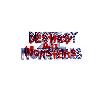In a college town called Ann Arbor, 50 miles west of the Big D, some anarchic art students were making noise collages, initially for their own amusement but sometimes to earn food at fraternity parties. They band members were not musical in the conventional sense of the term, but their singer Niagara had an atonal phrasing, and a discernible attitude, that was unique. Her Twilight Zone presence – Nico meets Nancy Sinatra over early evening Quaalude cocktails - positioned Destroy All Monsters in their own oddball zone.
DAM kicked off at the end of 1973 and didn’t gig much formally. Original members Mike Kelley and Jim Shaw dabbled in visual arts and eventually departed to make names in that space. Niagara has now made a name for herself as a visual artist, too. But back to DAM: Underground media attention only really followed with the recruitment of ex-Stooge Ron Asheton on guitar and then onetime MC5er and recently freed jailbird Mike Davis on bass. Cult status and endless booze and pills parties masquerading as tours were only a couple of low-budget 45s away.
There’s no need to downplay the significance of DAM – especially back in the ‘80s. They’ve since inspired people as diverse as Sonic Youth (Thurston Moore was behind a release of early recordings) and Madonna (as an Ann Arbor resident, she used to catch them live.) From an Aussie perspective, Destroy All Monsters (and some shitty bootlegs) were the last link between the cold corpse of the Stooges and the plethora of bands they were inspiring.
(As a callow youth on his first solo trip through the US in the ‘80s, the first thing I did after touching down at Detroit Metro was to find a phonebook and call an Ann Arbor record store to ask if DAM were playing anywhere locally. Alas, the answer was a stoned-sounding: “Ron Asheton and his band…I don’t think so, maaaan” and I had to wait until ’91 to catch Dark Carnival in the flesh when they swept through Australia.)
This double CD set on Spanish label Munster divides its time between the avant garde and the rock and roll line-ups. The arty tracks come from DAM’s earliest recordings, and reunion shows in 1995. Of the “rock” line-ups, there were really two distinct configurations; the first with Asheton augmented by the Miller brothers, Larry and Ben, on sax and rhythm guitar respectively, and the second had Ron filling most of the musical spaces himself.
If you’re a fan of the rock-oriented DAM (and the Niagara and Ron band that followed, Dark Carnival) you’ll still gravitate towards the five-CD band-issued “The Night That Never Ends” set, but otherwise this collection will do as the “go-to” overview of the band’s diverse stages. Its 31 tracks span two CDs or three LPs.
“"Hot Box” collates the better-known studio singles tracks - "Bored" b/w "You’re Gonna Die" (1978), "November 22nd, 1963” b/w “Meet The Creeper” and "What Do I Get?" b/w "Nobody Knows" (both 1979) - and their sound is enough of an improvement on previous CD jobs to justify your heard-earned. The mastering on some other tracks is occasionally lumpy but that’s life in the big city. Harder-to-find cuts like “Going To Lou’s”, 1999’s “Paranoid of Blondes”, “Jesus Is a Shotgun” and “Everybody Knows (Anyone Can Fuck Her)” will be an attraction – especially if you missed out on the French Revenge label CDs in the ‘90s.
The early singles may have had a home-grown feeling about the production but it would be criminal to dismiss them on the basis that the band should have spent money they never had on a top-flight studio.
If packaging matters (and it should) the chunky digipack and booklet are fabulously decorated with Carey Loren and Niagara artwork.
I readily admit I don’t entirely “get” the noisenik stuff. It’s the rocking stuff that puts the olive in my martini. But I get wry amusement out of the humour in many of these tracks – especially the thought of Niagara and co inflicting aural terrorism on audiences with live weapons like “I Love You But You’re Dead” and “That’s My Ideal” (surely the best Kim Gordon track she never recorded.)
As one sage recently pronounced: “Ron only had one lead break but it sure was a good one.” You can hear it exploding and spreading like napalm on “Ground Zero” and “What Do I Get.” These recordings also show the perfect dichotomy between Asheton’s stun guitar and Niagara’s disembodied vocalising.
All of which makes perfect sense to me. Stop thinking about it and go buy the fucking thing.






 It’s high time this stuff was collected in one place. If you’ve no idea who Destroy All Monsters were, boy, you’re in the wrong place. If you are in the know, consider yourself lucky, take a pill and strap yourself in for a short history lesson.
It’s high time this stuff was collected in one place. If you’ve no idea who Destroy All Monsters were, boy, you’re in the wrong place. If you are in the know, consider yourself lucky, take a pill and strap yourself in for a short history lesson.